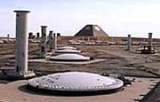
Safeguard Program
Encyclopedia

United States
The United States of America is a federal constitutional republic comprising fifty states and a federal district...
Army
United States Army
The United States Army is the main branch of the United States Armed Forces responsible for land-based military operations. It is the largest and oldest established branch of the U.S. military, and is one of seven U.S. uniformed services...
anti-ballistic missile
Anti-ballistic missile
An anti-ballistic missile is a missile designed to counter ballistic missiles .A ballistic missile is used to deliver nuclear, chemical, biological or conventional warheads in a ballistic flight trajectory. The term "anti-ballistic missile" describes any antimissile system designed to counter...
system developed during the late 1960s. Safeguard was designed to protect U.S. ICBM missile sites from counterforce
Counterforce
In nuclear strategy, a counterforce target is one that has a military value, such as a launch silo for intercontinental ballistic missiles, an airbase at which nuclear-armed bombers are stationed, a homeport for ballistic missile submarines, or a command and control installation...
attack, thus preserving the option of an unimpeded retaliatory strike
Massive retaliation
Massive retaliation, also known as a massive response or massive deterrence, is a military doctrine and nuclear strategy in which a state commits itself to retaliate in much greater force in the event of an attack.-Strategy:...
. Safeguard used much of the same technology of the earlier Sentinel Program, which had been designed to protect U.S. cities
Countervalue
Countervalue is the targeting of an opponent's cities and civilian populations. In contrast, counterforce refers to the targeting of an opponent's military personnel, forces and facilities.-Theory:...
.
Sentinel was developed but never deployed. Safeguard was planned for several sites within the United States, but only one was completed. Until the Ground-Based Midcourse Defense
Ground-Based Midcourse Defense
Ground-Based Midcourse Defense is the United States system for intercepting incoming warheads in space. Currently, it is a major component of the U.S. national missile defense strategy aimed against ballistic missiles, including intercontinental ballistic missiles...
system was deployed, the Stanley R. Mickelsen
Stanley R. Mickelsen
Stanley Raymond Mickelsen was an American military leader. Born in Minnesota, and a graduate of the University of Minnesota, Mickelsen joined the Army in 1917....
Safeguard complex in Nekoma, North Dakota
Nekoma, North Dakota
As of the census of 2000, there were 51 people, 21 households, and 12 families residing in the city. The population density was 136.7 people per square mile . There were 41 housing units at an average density of 109.9 per square mile...
, with the separate long-range detection radar located further north near the town of Cavalier, North Dakota
Cavalier, North Dakota
Cavalier is a city in Pembina County, North Dakota in the United States. It is the county seat of Pembina County. The population was 1,302 at the 2010 census. Cavalier was founded in 1877 and became the county seat in 1911....
, was the only operational anti-ballistic missile
Anti-ballistic missile
An anti-ballistic missile is a missile designed to counter ballistic missiles .A ballistic missile is used to deliver nuclear, chemical, biological or conventional warheads in a ballistic flight trajectory. The term "anti-ballistic missile" describes any antimissile system designed to counter...
system ever deployed by the United States. It defended Minuteman ICBM
LGM-30 Minuteman
The LGM-30 Minuteman is a U.S. nuclear missile, a land-based intercontinental ballistic missile . As of 2010, the version LGM-30G Minuteman-III is the only land-based ICBM in service in the United States...
missile silos near the Grand Forks AFB, North Dakota.

LIM-49A Spartan
The LIM-49A Spartan was a United States Army anti-ballistic missile, whose warheads were developed at Lawrence Livermore National Laboratory. It was a three-stage, solid-fuel surface-to-air missile that carried a W71 thermonuclear warhead with a lethal radius of up to 30 miles to intercept...
and sixteen Sprint
Sprint (missile)
The Sprint was a two-stage, solid-fuel anti-ballistic missile, armed with a W66 enhanced radiation thermonuclear warhead. It was designed as the short-range high-speed counterpart to the longer-range LIM-49 Spartan as part of the Sentinel program. Sentinel never became operational, but the...
nuclear tipped missiles (an additional fifty or so Sprint missiles were deployed at four remote launch sites). The complex was deactivated during 1976 after being operational for less than four months, due to concerns over continuing an anti-missile-missile arms race, cost, effectiveness, and changing political rhetoric.
The Russian counterpart to the Safeguard system was the Soviet A-35 anti-ballistic missile system
A-35 anti-ballistic missile system
The A-35 anti-ballistic missile system, or A-35 Aldan, was a Soviet military battle management radar complex deployed around Moscow to intercept enemy missiles targeting the city or its surrounding areas. In development since the 1960s and in operation from 1971 until the 1990s, It featured the...
, which defended Moscow and nearby missile fields. The Russian anti-missile-missile system remains in operation today as the upgraded A-135 anti-ballistic missile system
A-135 anti-ballistic missile system
The A-135 or ABM-3 anti-ballistic missile system is a Russian military complex deployed around Moscow to counter enemy missiles targeting the city or its surrounding areas. It became operational during 1995...
.
Operation
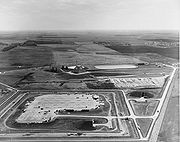
The envisioned sequence was as follows: first detection of enemy launch by Defense Support Program
Defense Support Program
The Defense Support Program is a program of the U.S. Air Force that operates the reconnaissance satellites which form the principal component of the Satellite Early Warning System currently used by the United States....
satellites, which sense the hot infrared exhaust of the ICBM booster. Then while in the mid-course phase, the Ballistic Missile Early Warning System
Ballistic Missile Early Warning System
The United States Air Force Ballistic Missile Early Warning System was the first operational ballistic missile detection radar. The original system was built in 1959 and could provide long-range warning of a ballistic missile attack over the polar region of the Northern Hemisphere. They also...
radars in the far north would detect the incoming warheads. As the warheads approached (but while still in outer space) the Safeguard long-range radar (called the Perimeter Acquisition Radar, or PAR) would detect them, providing filtered information to the shorter-range and more precise Missile Site Radar (MSR). While the incoming warhead came within range of the MSR, the associated computer systems would calculate intercept trajectories and launch times.
The Sprint missile was test launched 48 times, of which 41 were successful, and two partially successful. The Spartan missile was test launched 24 times.
Original deployment plan
Plans were made in the late 1960s to deploy Safeguard systems in three locations, Whiteman AFBWhiteman Air Force Base
Whiteman Air Force Base is a United States Air Force base located approximately south of Knob Noster, Missouri; east-southeast of Kansas City, Missouri....
, Missouri, Malmstrom AFB
Malmstrom Air Force Base
Malmstrom Air Force Base is a United States Air Force base and census-designated place in Cascade County, Montana, United States. It was named in honor of World War II POW Colonel Einar Axel Malmstrom...
, Montana, and Grand Forks AFB
Grand Forks Air Force Base
Grand Forks Air Force Base is a United States Air Force base located north of Emerado, North Dakota and approximately west of Grand Forks, North Dakota...
, North Dakota, to protect important strategic weapons assets. However the Whiteman AFB location was canceled despite the fact that specific missile and radar site locations had already been selected. Construction was actually commenced at the North Dakota and Montana sites, but only the North Dakota site was completed. Remnants of the incomplete PAR system still remain in rural Montana.
Components
The Safeguard system consisted of several primary components, the Perimeter Acquisition Radar, the Missile Site Radar, the Spartan missile launchers, co-located Sprint missile launchers, and Remote Sprint missile launchers.Perimeter Acquisition Radar (PAR)
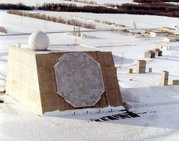
The PAR was a large phased array
Phased array
In wave theory, a phased array is an array of antennas in which the relative phases of the respective signals feeding the antennas are varied in such a way that the effective radiation pattern of the array is reinforced in a desired direction and suppressed in undesired directions.An antenna array...
radar that was intended to detect incoming ballistic missile warheads as they crossed over the North Pole region. This information was to be relayed to other command and control sites. Two were intended to be constructed on the northern border of the United States, one in Montana and one in North Dakota. Construction was begun at both locations, but because of the ratification of the Anti-Ballistic Missile Treaty
Anti-Ballistic Missile Treaty
The Anti-Ballistic Missile Treaty was a treaty between the United States and the Soviet Union on the limitation of the anti-ballistic missile systems used in defending areas against missile-delivered nuclear weapons....
(ABM treaty), only the site in North Dakota was completed. As of 2006, the North Dakota site, near Cavalier, North Dakota, is still operational and located at Cavalier Air Force Station
Cavalier Air Force Station
Cavalier Air Force Station is a United States Air Force installation in Pembina County, North Dakota, home to the 10th Space Warning Squadron of the 21st Space Wing based at Peterson Air Force Base in Colorado.-Mission:...
48°43′28.65"N 97°53′58.44"W. Remnants of the Montana site are located east of Conrad, Montana
Conrad, Montana
Conrad is a city in and the county seat of Pondera County, Montana, United States. The population was 2,753 at the 2000 census.-Geography:Conrad is located at ....
, at 48°17′15.83"N 111°20′32.39"W(not shown on topo, but visible on the aerial photo). Potential targets detected by the PAR would be sent to the Missile Site Radar (MSR) and to the North American Aerospace Defense Command
North American Aerospace Defense Command
North American Aerospace Defense Command is a joint organization of Canada and the United States that provides aerospace warning, air sovereignty, and defense for the two countries. Headquarters NORAD is located at Peterson AFB, Colorado Springs, Colorado...
(NORAD). The PAR site is listed in the Historic American Engineering Record, survey ND-9-P.
Missile Site Radar (MSR)
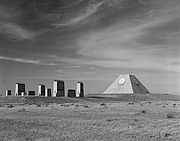
Nekoma, North Dakota
As of the census of 2000, there were 51 people, 21 households, and 12 families residing in the city. The population density was 136.7 people per square mile . There were 41 housing units at an average density of 109.9 per square mile...
, at 48°35′21.91"N 98°21′24.26"W. The remnants of the Montana system were dismantled and buried. It was possibly located at 48°08′25.77"N 111°45′26.16"W. Structures similar to the North Dakota site can be seen on aerial photography pictures of that site. The MSR complex included the Spartan missile and some Sprint missile launchers. The MSR is listed in the Historic American Engineering Record, survey ND-9-B.
Remote Sprint Launchers (RSL)
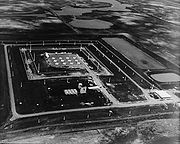
Photo gallery
Image: Safeguard Missile Site Radar.png|Safeguard Missile Site Radar
Image: Missile Site Radar Wide.png|Wide view of Missile Site Radar
Image: Remote Sprint Launcher -3.png|Remote Sprint Launcher #3
Image: Spartan Launcher.png|Spartan Launcher
Image: Msr_complex_sign.png|Missile Site Radar Complex sign
See also
- The Sentinel Program
- Strategic Defense InitiativeStrategic Defense InitiativeThe Strategic Defense Initiative was proposed by U.S. President Ronald Reagan on March 23, 1983 to use ground and space-based systems to protect the United States from attack by strategic nuclear ballistic missiles. The initiative focused on strategic defense rather than the prior strategic...
- Anti-ballistic missileAnti-ballistic missileAn anti-ballistic missile is a missile designed to counter ballistic missiles .A ballistic missile is used to deliver nuclear, chemical, biological or conventional warheads in a ballistic flight trajectory. The term "anti-ballistic missile" describes any antimissile system designed to counter...
(anti-missile-missile) - Strategic Arms Limitation TalksStrategic Arms Limitation TalksThe Strategic Arms Limitation Treaty refers to two rounds of bilateral talks and corresponding international treaties involving the United States and the Soviet Union—the Cold War superpowers—on the issue of armament control. There were two rounds of talks and agreements: SALT I and SALT...
- Anti-Ballistic Missile TreatyAnti-Ballistic Missile TreatyThe Anti-Ballistic Missile Treaty was a treaty between the United States and the Soviet Union on the limitation of the anti-ballistic missile systems used in defending areas against missile-delivered nuclear weapons....
- Cavalier Air Force StationCavalier Air Force StationCavalier Air Force Station is a United States Air Force installation in Pembina County, North Dakota, home to the 10th Space Warning Squadron of the 21st Space Wing based at Peterson Air Force Base in Colorado.-Mission:...
External links
- Unofficial website of the Stanley R. Mickelson Safeguard complex
- map showing SRMSC components in North Dakota
- Stanley R. Mickelson Safeguard Antiballistic Missile Complex
- FAS - Safeguard system
- 10th Space Warning Squadron - Current operators of the PAR system
- Global Security - Malstrom ABM site
- Aerial images of Safeguard ABM facilities
- Historical American Buildings Survey Images of Mickelson Safeguard Complex

